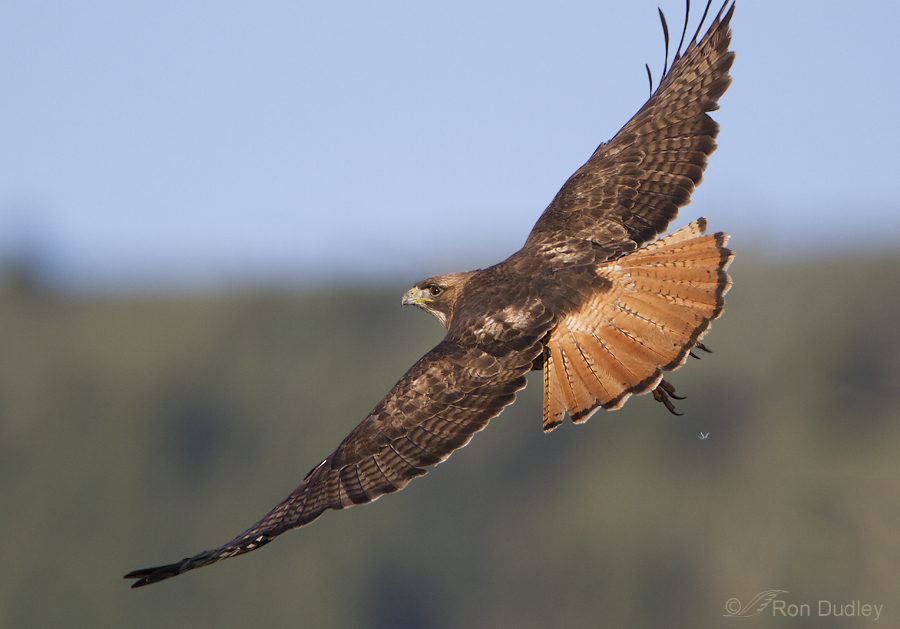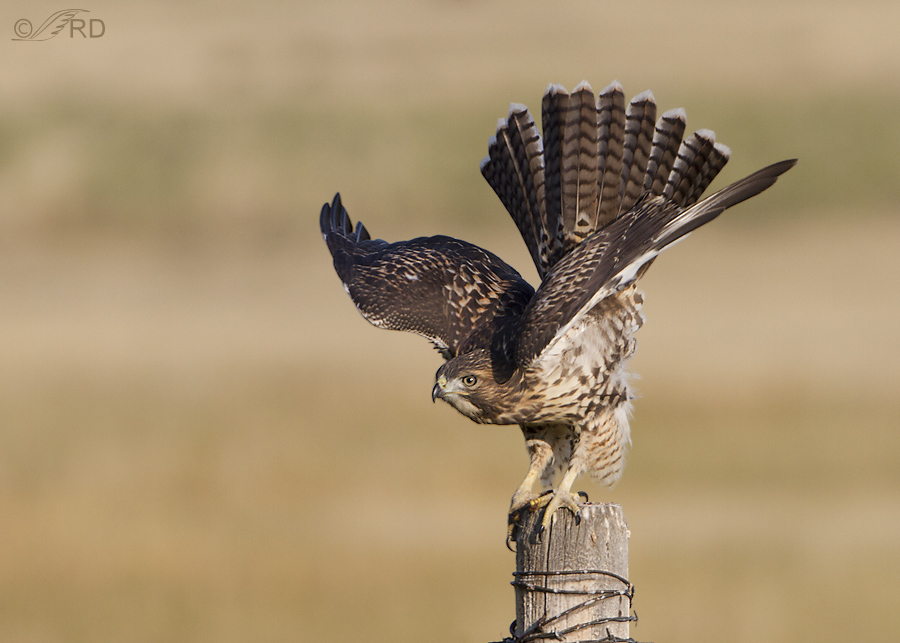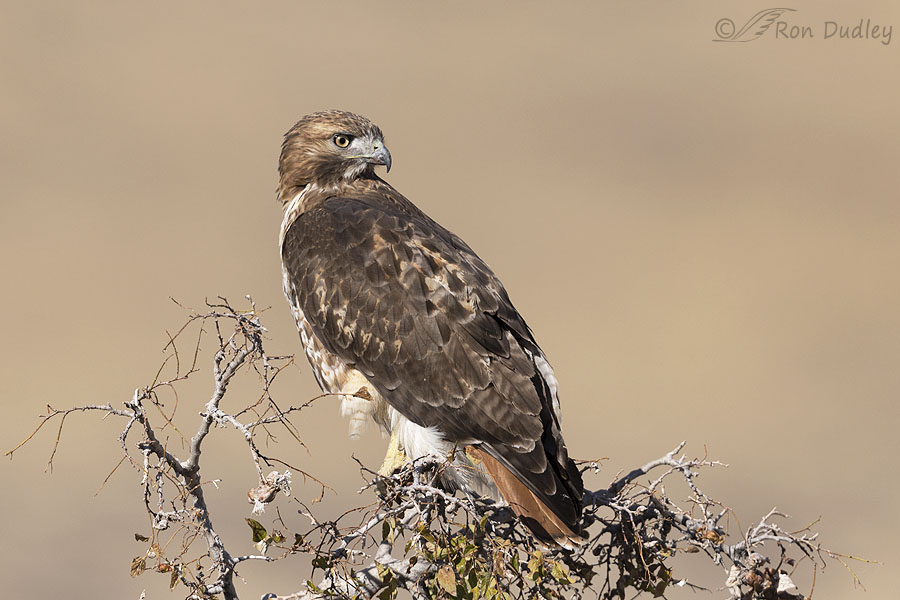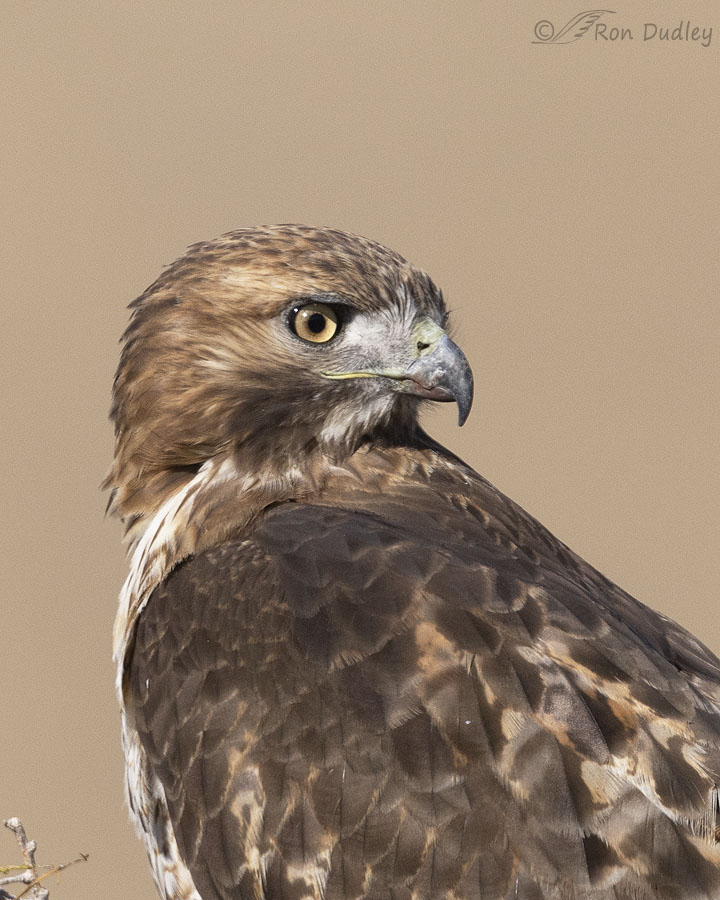The answer might surprise you.

As most raptor aficionados know, adult Red-tailed Hawks typically have dark brown eyes and distinctively red tails in the dorsal view.

Juvenile and immature Red-tailed Hawks have pale yellowish eyes and lack the red tail.
But the transition to having a red tail isn’t in lockstep with the change in eye color. The transformation of eye color from yellow to brown occurs over several years and it happens more quickly in some individuals than in others, so some adult Red-tailed Hawks with red tails still have yellow eyes.

As was the case with this Red-tailed Hawk I photographed two days ago in northern Utah. This bird has a red tail but its eyes are still yellow.
So beware of using eye color exclusively to distinguish adult Red-tailed Hawks from juveniles or immature birds. Yes, it’s nearly always true that Red-tailed Hawks with dark brown eyes are adults but some adults (with red tails) only a year or two old may still have yellow eyes.

And I love looking into those yellow eyes from up close. To me, for no logical reason I can think of, they seem to have more depth and character than the dark eyes of adults.
They make me wonder what the bird was thinking when I took the photo.
Ron
Notes:
- If you’re interested, my friends at HawkWatch International covered this subject in slightly more detail in one of their blog posts.
- And speaking of HWI, yesterday on their Facebook timeline in celebration of Halloween they featured a photo of my old friend Galileo (the Short-eared Owl I cut out of barbed wire) doing what he now does best as an education bird in their raptor ambassador program. If you’re on Facebook you should be able to see it so here’s the link.


Great information and super series Ron!
Charlotte Norton
Thanks, Charlotte.
Excellent photos, as usual. Plus some good advice.
Red-tails are quite variable, especially here in the west. I just checked my copy of Brian Wheeler’s Birds of Prey of the West and see that he devotes 14 color plates to Red-tailed Hawk.
Thanks, Richard. I believe they’re our most variable buteo.
Typo, sorry Ron
Those photos took my breath away! So nice rose your posts today!
Thanks, Angela.
The educator continues to amaze and teach!
I’ve been following a Red-tailed Hawk for about year and, just as you pointed out, its tail is transitioning to reddish, but those eyes are still quite yellow. Will be interesting to see if I can keep up with it for another year and see how those eyes progress.
Thank you for sharing more fabulous photographs of a magnificent raptor.
Wally, it’s pretty special that you’ve been able to follow the same red-tail for that long. And I’m glad you’re interested in watching the timing of its color changes.
And some humans mature at different levels and ages too.
Glorious photos.
And for a change I am a bit sorry that I don’t play Farce Book (though I loved the photos I was able to scroll through.
Thanks, EC. There’s definitely a price to pay for being on social media.
I agree those pale yellow eyes hold more appeal than the dark red … such clarity, it’s like looking into the raptor’s soul … perhaps it’s just more natural light than the catchlight you need in the dark eyes to bring the bird to life. I don’t think I’m saying that right but I never said I was logical. Love the photos, of course, and the “visit” with Galileo. ♥️
Chris, I can’t explain why I find the lighter eyes more intriguing; I just do.
The first photo shows the tail like I’ve never seen. More than makes up for the clipped wing
Just when I thought I was getting raptor ages down, you come and burst my bubble. And HWI’s insights are phenomenal; aging by molt patterns. Wow.
No photo specs. No matter, I know you have a reason.
Hey, it’s Galileo. He’s looking toward the heavens, as his bio states:
https://hawkwatch.org/learn/hwi-birds
Lyle, as you can imagine I was really bummed to clip that wing.
I was tickled to see them post that photo of Galileo. I haven’t been able to visit him at HWI since the pandemic began so seeing that photo was the next best thing.
Always interesting information here, Ron. I especially love the bird on the post. Elegant in every detail. Thanks.
Ellen, that bird on the post started to take off and then changed its mind at the last second – thus the unusual pose.
Beautiful photos and a very useful educational piece. Thanks Ron. I take lots of Red-tail photos and have noticed the different eyes, but was not aware of why.
Thank you, Everett.
Thank you for ever-constant education.
Karen
You’re welcome, Karen.
love the yellow eyes! I have been slow in sending my book reccomendations to you although I am a reader of history as well. But there is one book that I want to make sure I tell you about: Hawaiki Rising. It is a wonderful story of people, adventure and wisdom.
Also, have you ever read the books of Ivan Doig? while they are fiction many of them deal with the Montana area in the early days and he is a magnificent writer.
I hope your convalescence is going well. thank you for continuing to share interesting bird topics with us.
Thanks for the suggestions, Catherine. I have several of Doig’s books, including Dancing at the Rascal Fair.
Interesting info about the progression of eye-color change……but I’m a
beauty-junkie, and in shot #4 of today’s post-the detail shot– I’m knocked out
by the texture of the bird’s shoulder cape–so lustrous that it looks like a field of articulated velvet…..thanks for the “fix” !
Always glad to provide a bird fix for my readers, Kris.
Beautiful birds and good information tho I’m rarely close enough to notice that! Galileo interested in “something” other than the photographer…always good to see updates on him…
Galileo interested in “something” other than the photographer…always good to see updates on him… 
Glad you’re out and about!
Judy, I wondered what Galileo was looking at too – especially at that angle.
Thank you. I’m delighted the pain has abated enough that you can begin to take up your passion again. So wonderful for us to learn so much from your beautiful photos.
Thank you, Cheryl.
Thank you Ron for the photos and yet another interesting tutorial.
Galileo looks very fit. Must do your heart good to see him doing so well, and bringing happiness and stirring-up interest in our young folk.
Well done, sir!
Michael, it does my heart LOTS of good. Especially when I think of what almost was…
Thank you, Ron, for the amazing chance to look into the birds eyes and learn so much about them!
You are welcome, Mary.
Beautiful exposures and compositions. We see this in the Bald Eagles as well, and bill color also changes from dark to bright yellow as the bird matures.
Thanks, Kenneth. Most buteos have color transitions of one kind or another as they mature.